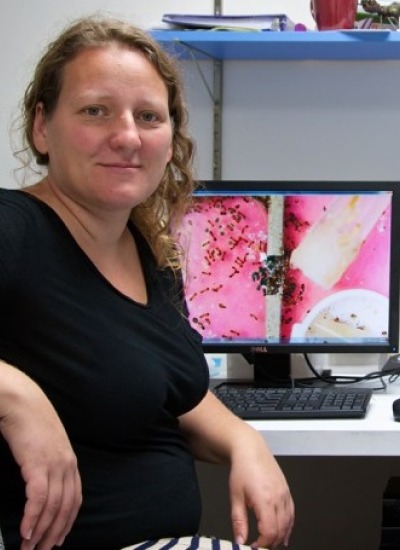Anna R Dornhaus
Publications
Abstract:
Within-group conflict may influence the degree to which individuals within a group cooperate. For example, the most dominant individuals within a group often gain access to the best resources and may be less inclined to perform risky tasks. We monitored space use and division of labor among all workers in three colonies of bumblebees, Bombus impatiens, during the ergonomic and queenless phases of their colony cycle. We then measured the two largest oocytes in each worker to estimate each individual's reproductive potential at the end of the colony cycle. We show that workers that remained farther from the queen while inside the nest and avoided risky or more energy-expensive tasks during the ergonomic phase developed larger oocytes by the end of the colony cycle. These individuals also tended to be the largest, oldest workers. After the queen died, these workers were more likely than their nestmates to increase brood incubation. Our results suggest that inactive bumblebees may be storing fat reserves to later develop reproductive organs and that the spatial organization of workers inside the nest, particularly the distance workers maintain from the queen, may predict which individuals will later have the greatest reproductive potential in the colony. © 2011 Springer-Verlag.
Abstract:
Social insects like ants and bees live in cooperative colonies containing up to millions of individuals. These colonies are sometimes termed 'superorganisms' and have evolved tightly integrated and sophisticated collective behaviours. Different species, however, often differ in the type and mechanisms of communication and collective organization employed. I show here how individual-based models can be used to identify the non-intuitive benefits of different mechanisms of communication and division of labour and how these benefits may depend on the external environment as well as traits of the society itself. This allows us to understand under what ecological conditions particular types of collective organization may have evolved, and thus can also help to explain variation among species. © 2012 Copyright Taylor and Francis Group, LLC.
Abstract:
A honey bee colony (Apis mellifera Linnaeus) frequently adjusts its nectar foraging effort to changes in foraging conditions. It is possible that workers use a volatile substance, e.g. a pheromone, to quickly activate foragers in all regions of the hive. To test whether volatiles from a foraging colony can activate foragers of a non-foraging colony, two colonies, each restricted to a different greenhouse, were connected with a glass tube that allowed volatiles to drift between colonies. During the experiment, one colony was allowed to forage unscented sugar water. The scent of the foraging colony was fanned into the colony that did not have sugar water available, and the number of times that workers each left the hive and arrived at the empty feeder station was recorded. The number of visits of the empty feeder by foragers from the non-foraging colony tended to increase, while the number of times that bees left the hive did not seem to change. The result suggests an increase in foraging motivation of already active foragers. However, the results will have to be corroborated by further experiments. © 2007 E. Schweizerbart'sche Verlagsbuchhandlung.
Abstract:
1. Bumble bees exhibit worker size polymorphisms; highly related workers within a colony may vary up to 10-fold in body mass. As size variation is an important life history feature in bumble bees, the distribution of body sizes within the colony and how it fluctuates over the colony cycle were analysed. 2. Ten commercially purchased colonies of Bombus impatiens (Cresson) were reared in ad libitum conditions. The size of all workers present and newly emerging workers (callows) was recorded each week. 3. The average size of bumble bee workers did not change with colony age, but variation in body size tended to decrease over time. The average size of callows did not change with population size, but did tend to decrease with colony age. In all measures, there was considerable variation among colonies. 4. Colonies of B. impatiens usually produced workers with normally distributed body sizes throughout the colony life cycle. Unlike most polymorphic ants, there was no increase in worker body size with colony age or colony size. This provides the first, quantitative data on the ontogeny of bumble bee worker size distribution. The potential adaptive significance of this size variation is discussed. © 2010 The Authors. Journal compilation © 2010 The Royal Entomological Society.


